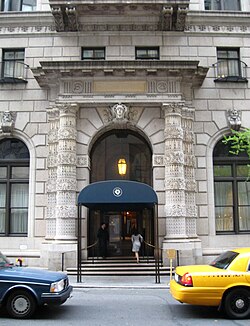University Club of New York
University Club | |
 1 West 54th Street | |
| Location | 1 West 54th Street, Manhattan, New York City, New York |
|---|---|
| Coordinates | 40°45′41″N 73°58′32″W / 40.7613°N 73.9756°W |
| Area | less than one acre |
| Built | 1899[2] |
| Architect | Charles Follen McKim of McKim, Mead, and White |
| Architectural style | Italian Renaissance Revival |
| NRHP reference No. | 80002726[1] |
| Significant dates | |
| Added to NRHP | April 16, 1980 |
| Designated NYCL | January 11, 1967 |
The University Club of New York (also known as University Club or UClub) is a private social club located at 1 West 54th Street at Fifth Avenue in Manhattan, New York, New York. It received its charter in 1865, but the origins date back to the autumn of 1861 when a group of college friends, principally Yale alumni, founded the club hoping to extend their collegial ties. The club is not affiliated with any other University Club or college alumni clubs.
History
The first meeting was held in the rooms of the Columbia College Law School (now the Columbia University Law School), where Theodore Dwight, the Club's first president and a Hamilton College alumnus, was a professor. After several moves, the club took over an existing town house at 26th Street and Madison Avenue in 1883.
Founded to celebrate the union of social duty and intellectual life, the Club states in its charter that the purpose of the organization shall be the "promotion of Literature and Art by establishing and maintaining a Library, Reading Room and Gallery of Art, and by such other means as shall be expedient and proper for such purposes." In addition to its many grand architectural features, the University Club hosts one of New York's great private art collections, with a particularly strong group of works by great American painters such as Gilbert Stuart and Childe Hassam, who featured the Club's facade in his work "Allies Day, May 1917".
The club was all-male until 1987.[3]
Building
By the 1890s, with its membership limited by the size of its building to 1,500 resident members and 900 who lived elsewhere, the Club was looking for a larger space, because it had nearly 600 people on a waiting list to join. It acquired the St. Luke's Hospital site and proceeded to seek an architecture firm. The firm of Charles McKim, William Mead and Stanford White, who were all members, got the architectural commission and went on to design what remains one of the grandest clubhouses of the city's prominent social clubs.
Erected in 1899 in a Mediterranean Revival Italian Renaissance palazzo-style and particularly noted for its reading room (with ceiling murals by H. Siddons Mowbray modeled after the Vatican Apartments), dining room, and the attempt made by the architects to disguise a nine-story building behind what seems to be a three-story facade.
McKim, Mead and White commissioned Edward F. Caldwell & Co. to provide light fixtures for the University Club among other architectural commissions for the company.[4]
See also
References
- ^ "National Register Information System". National Register of Historic Places. National Park Service. July 9, 2010.
- ^ "AIA Guide to New York City, 4th Edition, page 295
- ^ http://pagesix.com/2016/06/08/that-time-hillary-clinton-was-kicked-out-of-university-club/
- ^ Doug, Dunlop. "Shedding Light on New York: Edward F. Caldwell & Co". Smithsonian Institution Libraries.
External links
- 1865 establishments in New York
- Cultural infrastructure completed in 1899
- Buildings and structures in Manhattan
- Clubhouses on the National Register of Historic Places in Manhattan
- Clubs and societies in the United States
- Italian Renaissance Revival architecture in the United States
- Traditional gentlemen's clubs in New York City
- Midtown Manhattan





